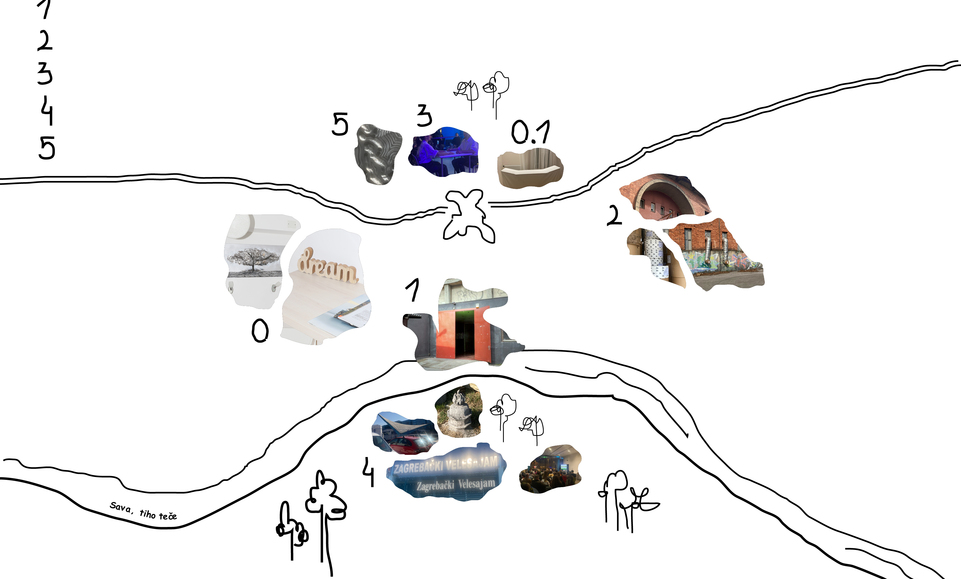Having been to Zagreb many times before, I now enter it with a specific quest, allowing myself to perceive it through a different lens. I like to picture this city as a vast garden, alive yet unknown. Welcomed by its diversity, I have already witnessed cycles of growth, decay, and renewal, absorbing its beauties and dirt* as I moved along. Sum of its parts feels abundant, even if some remain untended, wild. Rethinking the way one moves through the garden, I started to map my explorations. Nothing too ambitious for now, just an attempt at organisation and gathering clarity. I assume it will change over time.
0-0.1
The first week has been a bit of a rollercoaster ride for me, particularly due to an immediate issue with my accommodation. My most significant spatial engagement this week was, therefore, with my residential home. Arriving in Zagreb, I landed in a temporary Airbnb where I spent the first four nights. Despite its two bedrooms, three beds, and two bathrooms, it felt strangely unaccommodating—the feeling of its liminality was striking. The apartment seemed designed to push you out into the city rather than offer comfort or encourage settling in. The limitations of the natural light and fresh air were an unpleasant surprise. Clearly, this was a transient space, meant for brief (tourist) stops: a place to refresh, shower, sleep, and then move on. The cooking missions were literally missions, but I stayed with them regardless, determined to claim some agency over my temporary home. However, there were two details, decoration choices, that spoke to me on the first sight. One was a wooden object on the bedside table. Dream, it said. The other was a painting of a tree positioned right above the bed which I recognised as an invitation of a certain kind. The symbolism of both objects reassured me that I am on the right track, reminding me to pay attention to my inward travels just as much as I would explore the outward ones during the residency program. I managed to develop a relation with this liminal space, transcending its primary function. After four nights, I moved to my initially rented Airbnb, this one was still a work in progress, under (mild) construction. Compared to the first one, its spaciousness reached another level. The sterile quality remained, but this time, the emptiness felt different: open, like a blank sheet of paper waiting to be inhabited with a personal story. Yet, the construction workers were returning for another four days, so I was able to really ground into the new environment only on the ninth day of my stay. During the process of settling within both apartments, I started to wonder about the residential situation of the city.
1-5
Pogon Jedinstvo and Močvara on Monday, captivated me with their resilience, stability and tradition they established in the span of over 20 years. However, the question remains: how to constructively engage younger generations in their evolution? These spaces, much like long established garden beds, require both careful tending and new methods of propagation to ensure their future vitality. Tuesday brought me to a partially abandoned modernist architectural pearl right next to the city center, Klanonica. It holds immense potential for experimental, DIY use or a formal reconstruction and programming for a wider audience. But how can the historical aspects and original function of the building relate to its future cultural use? I wonder if tensions exist between preservation and transformation, and if so, how they might be reconciled to meet contemporary needs. On the thematic walk with Saša Šimpraga, we were briefly introduced with his projects 50 Poems for Snow and The Palm Tree, which encourage imaginative perspectives on contemporary urban issues. I believe playfulness has a profound impact on regenerating urban landscapes—like aerating the soil, allowing new roots to form. Wednesday and Friday led me to MAMA and Studio Galerija Klet, where I recognised many parallels to the cultural spaces I engage with on a daily. At first glance, it seems they are going through their own spring. Thursday was an especially overwhelming day, reserved for Zagrebački Velesajam and later, the MSU. One could feel the weight of historical context that the Velesajam carries. Nowadays, a reminder of an ambitious dream and monumental symbol of socialist development, embodying the aspirations of a growing proletariat after the Second World War. There is hope that the Velesajam could transform into a dynamic cultural nest in the future, adapted to contemporary needs. The events in the MSU nevertheless informed me how the artists, various initiatives, and organisations actively address the spatial struggles within the independent cultural scene. They explore possibilities for urban gardening, alternative models of sustainability and community engagement, and experimental uses of public space.
The rising issues in the cultural sphere are related both to finding and also cultivating spaces. Artists and communities have of course an important role in reshaping Zagreb’s urban fabric through acts of care, resistance, and continuity. Just as in an ecosystem, the survival of one part is dependent on the resilience of the whole. The ethos of independent cultural actors seems deeply rooted in these values; honouring duration, process, and relationality. I would add that there is wisdom in slowness, in allowing space to be inhabited rather than consumed, in fostering environments that prioritise presence over productivity. It is what I aim to do with my explorations of the new garden, and its paths. I assume the map will grow, but also change with time.
* It is the mother, a womb, a source of creation. It is life and death.

